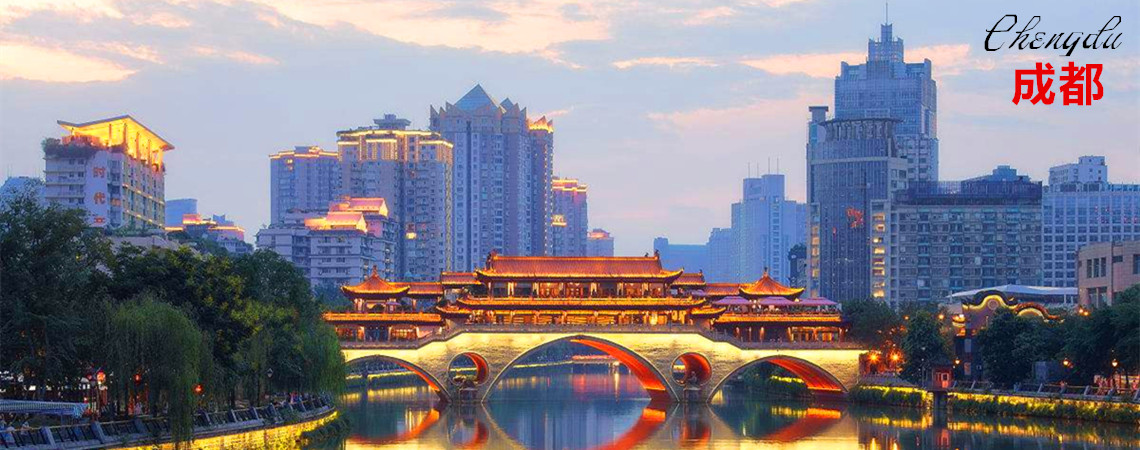
Qingcheng Mountain
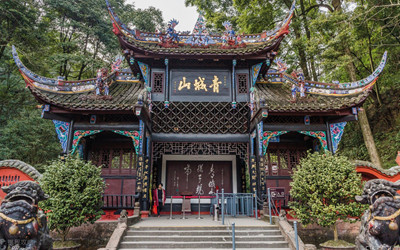 Qingcheng Mountain is located in the southwest of the Dujiangyan Irrigation System in Sichuan Province. Mount Qingcheng is one of the most famous Taoist mountains in China. It is also a very attractive and intriguing scenic spot that is covered by luxuriant and verdant trees. The mountain, which is surrounded by numerous peaks and is shaped like a city, is dubbed 'the most peaceful and secluded mountain under heaven' and combines perfectly with its evergreen scenery.
Qingcheng Mountain is located in the southwest of the Dujiangyan Irrigation System in Sichuan Province. Mount Qingcheng is one of the most famous Taoist mountains in China. It is also a very attractive and intriguing scenic spot that is covered by luxuriant and verdant trees. The mountain, which is surrounded by numerous peaks and is shaped like a city, is dubbed 'the most peaceful and secluded mountain under heaven' and combines perfectly with its evergreen scenery.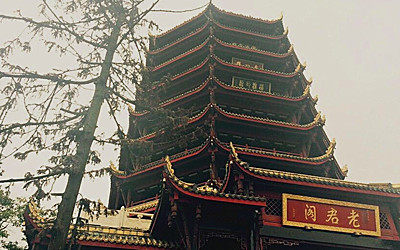 What to see ?
What to see ?
The Mount Qingcheng can be divided into two parts - the anterior part and the posterior part. The anterior part is the main part of the scenic spot, covering an area approximately 15 square kilometers (about 3706 acres) that possesses alluring natural beauty and an abundance of cultural relics and historic sites. Among them, the Jianfu Palace, the Shangqing Palace, and the Tianshi Cave are some of the most famous destinations which you are bound to be engrossed by.
Laojun Pavilion
Looking up at Mt. Qingcheng from its foot, you will see that Laojun Pavilion is located on the highest peak, which is known as Pengzu Peak, it is also called Laoxiao Peak, which has an elevation of over 1,260 meters.
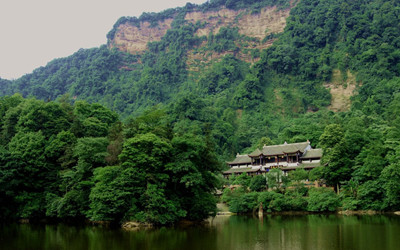 Jianfu Palace
Jianfu Palace
As you begin to climb up Mt. Qingcheng you will discover the Jianfu Palace, which was originally constructed in the Tang Dynasty (618-907) and was restored on several other occasions through the years. Now, two temples and three compounds also exist here, surrounded by lush ancient vegetation. In front of the Jianfu Palace, a lucid stream winds its way, adding more beauty to the whole environment. Going west for one kilometer (about 0.6 mile), visitors will suddenly be presented with a wooden pavilion that protrudes between a profusion of trees and steep rocks. As a result, most of visitors will have misconception impressions that they are in a large natural painting.
Tianshi Cave
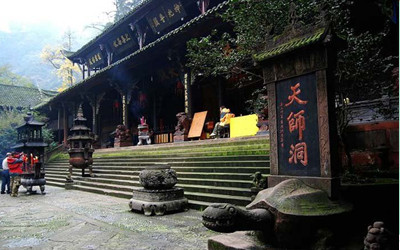 Going west, you will arrive at the Tianshi Cave. It is the major temple here. In the cave, a stone statue in the style of Sui Dynasty (581-618), proudly stands of Zhang Tianshi (the Celestial Master Zhang) who is worshipped. According to the legend, Zhang Daoling, later known as Zhang Tianshi, cultivated himself and preached here around the end of the Eastern Han Dynasty (25-220). Hence, Zhang Tianshi is known as the founder of Taoism on Mt. Qingcheng. We also recommend that you visit the three other buildings that exist in this area - the Sanhuang Palace, the Sanqing Palace and also the Huangdi Temple. The Sanqing Palace, the main hall of the Tianshi Cave, worships the three supreme deities in Taoism; while in the Sanhuang Palace, the stone statues of Fuxi, Shennong and Huangdi (the Three Sovereigns of legendary rulers of China in remote antiquity) are worshipped.
Going west, you will arrive at the Tianshi Cave. It is the major temple here. In the cave, a stone statue in the style of Sui Dynasty (581-618), proudly stands of Zhang Tianshi (the Celestial Master Zhang) who is worshipped. According to the legend, Zhang Daoling, later known as Zhang Tianshi, cultivated himself and preached here around the end of the Eastern Han Dynasty (25-220). Hence, Zhang Tianshi is known as the founder of Taoism on Mt. Qingcheng. We also recommend that you visit the three other buildings that exist in this area - the Sanhuang Palace, the Sanqing Palace and also the Huangdi Temple. The Sanqing Palace, the main hall of the Tianshi Cave, worships the three supreme deities in Taoism; while in the Sanhuang Palace, the stone statues of Fuxi, Shennong and Huangdi (the Three Sovereigns of legendary rulers of China in remote antiquity) are worshipped.Shangqing Palace
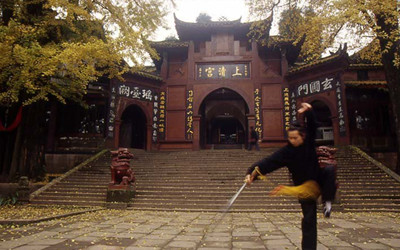 Then, leaving the Tianshi Cave and crossing the Fangning Bridge, visitors will arrive at the Zushi Palace which is preserved from the Qing Dynasty (1644-1911). By continuing along the path, visitors will reach the next famous temple - the Shangqing Palace, and one by one a series of natural scenery and revered buildings of Taoism will present themselves to visitors. The Shangqing Palace was originally built in the Jin Dynasty; however, only a part of the buildings that were constructed in the Qing Dynasty remain. Fortunately, it is still an attractive sight where you can enjoy the unique natural scenery and historic heritages of China.
Then, leaving the Tianshi Cave and crossing the Fangning Bridge, visitors will arrive at the Zushi Palace which is preserved from the Qing Dynasty (1644-1911). By continuing along the path, visitors will reach the next famous temple - the Shangqing Palace, and one by one a series of natural scenery and revered buildings of Taoism will present themselves to visitors. The Shangqing Palace was originally built in the Jin Dynasty; however, only a part of the buildings that were constructed in the Qing Dynasty remain. Fortunately, it is still an attractive sight where you can enjoy the unique natural scenery and historic heritages of China.
By visiting Mt. Qingcheng, visitors will be able to savor the pleasure of the perfect combination of the unique landform, moderate climate, natural beauty and cultural relics and historic sites of Taoism in this area.
Travel Tips
Add: in the southwest of the Dujiangyan Irrigation System of China in Sichuan Province,China
Entrance Fee: CNY 125
Cable Car: CNY 35 (single trip), CNY 60 (round trip)
Opening Hours: March 2 to November 30: 08:00 to 18:00; December 1 to next March 1: 08:30 to 17:00
Time for a Visit: half day






 Ask Questions ?
Ask Questions ?